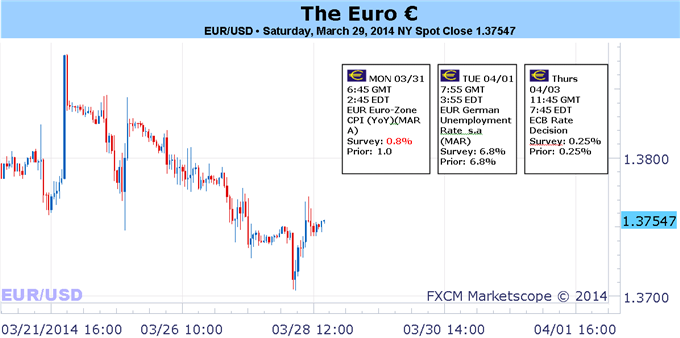
Fundamental Forecast for Euro: Neutral
– The Euro’s vulnerability was on full display this week.
– Shifting fundamental momentum sees the Euro losing key support to the Australian and US Dollars.
– Have a bullish (or bearish) bias on the Euro, but don’t know which pair to use? Use a Euro currency basket.
The European Central Bank’s dovish rhetoric show hit the road this week as policymakers continued the pushback against the perceived hawkish nature of the March policy meeting. Several different policymakers commented on the fragmented state of Euro-Zone credit, the impact of the elevated Euro exchange rate on inflation, and the prospect of additional non-standard easing in the months ahead. The timing couldn’t be more calculated with the central bank set to gather once again this coming Thursday.
It’s been made clear in the past two weeks, however, that ECB policymakers are viewing the actions taken at the March meeting as far too hawkish. There has been considerable pushback from ECB officials everywhere, including from ECB President Mario Draghi and Bundesbank President Jens Weidmann. The fact that two of the more patient, monetarily conservative members have softened their tone is a strong indication that the ECB feels it may have made an errant signal to the market.
We’ve long argued that the ECB would withstand the calls for further easing as crisis conditions remained absent and economic data steadily improved. This has been the case, which is why the ECB has done little but for a meager 25-bps rate cut in November. Sovereign yields remain at or near multi-year lows across the continent – Germany, Italy, Spain, Portugal – but now there are signs that funding pressures may be building. Excess liquidity in the Euro-Zone has dropped to €104B, the lowest level since before the first LTRO in December 2011, which has started to put more pressure on interbank lending rates.
A look at EONIA shows conditions have tightened further the past week. The interbank rate settled at 0.174% on Friday, just above the 20-day average EONIA rate at 0.170%; up from 0.157% one-month early (February 28), and up from 0.155% three-months earlier (December 27). We point to the ECB’s Asset Quality Review (AQR) as a source of apprehension – there is little logic to taking on more risk amid the first ECB-led stress tests.
The difference between where we stand today from say, the eve of the ECB’s March meeting, is that the economic data climate has worsened noticeably, undercutting the one true source of stability for ECB policy. There were surprisingly low inflation readings out of two of the Euro-Zone’s largest economies at the end of the week (Germany and Spain), and it is very possible that the flash Euro-Zone inflation report on Monday shows yearly inflation down to a +0.5% y/y or +0.6% y/y pace, either of which would be a post-2008 crisis low.
The Citi Economic Surprise Index fell to a fresh 2014 low this week, hitting -7.4 on Wednesday and settling at -3.8 on Friday, its lowest weekly closing level since November 1, 2013 (-3.8) – the ECB cut its main refinancing rate just six days later at its November policy meeting. The sudden downswing in growth momentum, alongside the soft inflation environment, has elevated the likelihood of further dovish action by the ECB this week. The time for ECB action may be nearing, but with speculation building that something might happen – EUR long contracts were reduced by -25.6% this week, per the CFTC’s COT report – a lack of a concerted policy response could just as easily send the Euro back towards its yearly highs. –CV
To receive reports from this analyst, sign up for Christopher’s distribution list.
DailyFX provides forex news and technical analysis on the trends that influence the global currency markets.Learn forex trading with a free practice account and trading charts from FXCM.
Source: Daily fx

